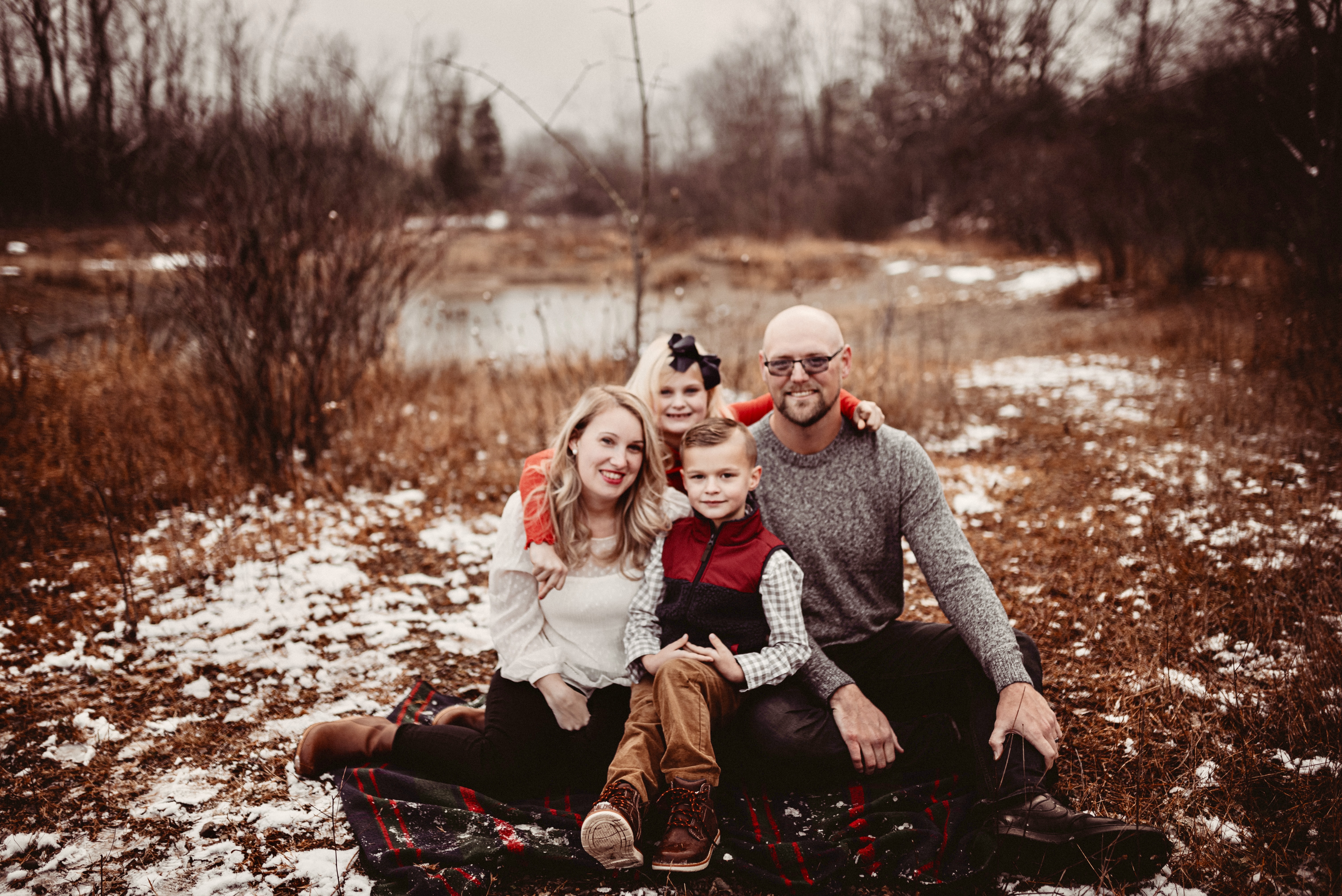
Name: Becky Detlef
Location: New York, United States
Child’s Birth Year: 2013
Keywords: Loss Parent, Board of Directors
Becky—who serves as the secretary on the board of directors for Hope for HIE—is the mother of two beautiful children, Hannah and Nick, aged seven and five respectively. She has been married to her husband, Josh, for ten years, lives in Buffalo, New York, and works as a financial aid officer in higher education. In 2013, when she gave birth to her first child, Ethan, who eventually died due to HIE, she learned just how immense both love and loss could be. Becky’s journey with HIE is not about hope in its “typical” form. It’s not about the hope that a child will walk or utter his first words or live a long life. Becky’s hope was different—a hope that Ethan would no longer suffer, and a hope that his legacy and story could create meaningful change for our community.
Although nothing was medically wrong during her pregnancy with Ethan, it was an extremely difficult time for Becky. Not only had Becky experienced miscarriages before—causing added stress that history would repeat itself—but twenty weeks into her pregnancy, on the exact day she had an ultrasound and found out the sex of her baby, her mother was diagnosed with terminal lung cancer. The day she received some of the most exciting news of her life was also the day she received some of the most devastating. It was extremely important to Becky that her mother be present for Ethan’s birth, so her OB and her mother’s cancer doctor coordinated a date for Becky to be induced that did not conflict with her mother’s chemo treatment.
The day of her induction, exactly at the forty-week mark of her pregnancy, Becky went into the hospital feeling great physically, with no issues outside of her stress levels. However, after she was induced, the process just felt extremely long and uncomfortable, and she started experiencing shooting pains and what felt like contractions in her back (“back labor”). In addition, during the labor, Ethan’s heart rate fluctuated, and there were many times during the process where it seemed like they were losing his heartbeat. However, the clinicians and nurses reassured her there was no larger cause for concern—back labor was common for many first-time mothers, as were the interspersed moments of Ethan’s heart rate dipping.
Over twenty-four hours after Becky had started labor, they were losing Ethan’s heartbeat again, so an internal heart rate monitor was placed. Suddenly, the whole atmosphere of the room shifted dramatically—the previously casual mood transformed into sheer panic, and, as what seemed like fifteen people rushed in to prepare Becky for an emergency C-section, Becky felt like she was living through the climactic scene of a horror movie. As Becky was rolled out to be transferred to the OR, her mother-in-law quickly squeezed her hand and let her know that everything was going to be fine. And, in that moment, Becky really believed it too—in the stories she had heard of something unexpected happening during labor, they almost always ended with “but, fortunately, it was just a scare.” As she would soon find out, though, this was not merely a false alarm.
Everything that happened next in that OR was a blur of chaos, but the one thing that Becky vividly remembers is the kindness of the anesthesiologist, who held her hand, and sat by her side throughout the entire procedure. When Ethan was finally born, it took a full twenty minutes for him to be resuscitated. The next thing Becky knew, she was in the recovery room, with her mother somehow waiting for her. Her mother started to talk to her lightheartedly about the latest gossip about the Kardashians, and while it may seem unusual to have such a conversation after such a traumatic birth, this distraction was what Becky really needed in the aftermath. In a state of immense shock, it was just too overwhelming and painful for Becky to think about what had just happened.
After his birth, Ethan was transferred to a larger hospital via ambulance, since the one they were currently at did not even have a NICU. Josh accompanied Ethan immediately, but Becky had to wait a little bit before being transferred to the new hospital, since she was still recovering from the C-section. For Becky, the time Ethan was in the NICU was actually the best part of her HIE journey. All the nurses and doctors were unbelievably kind, and, although learning about Ethan’s prognosis was beyond devastating, Becky could not have asked for a more supportive care team.
Upon arriving at the NICU, Ethan was cooled for three days, and, after that, he received an MRI. MRI day was awful—the doctors told Becky that babies who present like Ethan never do well, and while this is something no mother ever wants to hear, she appreciated how they were honest and upfront instead of providing her with false hope.
During the NICU stay, it became apparent that Ethan was seizing constantly and was in critical condition. Thus, after a second MRI that showed even worse results than the first, Becky and Josh decided to sign a do not resuscitate (DNR) for Ethan. Everyone was prepared for him to die right as he came off the ventilator, but, surprisingly, he survived and was able to breathe on his own. Ethan was still very sick, and he was discharged from the NICU two weeks later still on an NG-tube, as Becky didn’t want to prolong his suffering.
Those days at home were beyond difficult. Becky watched both her son and her mom die simultaneously, and Ethan was constantly crying and seizing. At 5:00 a.m. one morning, Becky went to put in Ethan’s NG-tube, and he made a croaking sound that she will never forget. In that awful moment, she thought she killed him by misplacing the tube.
That day, they went to the doctor, removed Ethan’s NG-tube, and put him in hospice care. He passed away five days later.
Right after Ethan’s funeral, the family went on a healing trip to Florida for a week. The day they returned home, Becky’s mother went to the hospital and never left. She died six weeks after her grandson.
Becky doesn’t remember the details of life immediately following such losses—she tries to recall the eulogy at her mother’s funeral, or the dress she wore, or where she sat, but it’s as if her brain hasn’t allowed her to remember that period in her life. But she kept going, and waking up each morning, because she had no other choice—in the face of unthinkable tragedy, we often find that we are more resilient than we think. And throughout her entire journey with both Ethan’s HIE and her mother’s cancer diagnosis, Becky may not have found hope or comfort in knowing that her two loved ones would lead long, healthy lives for years to come, but she did find hope in knowing they were no longer suffering. For Becky, she must have cried every single day when Ethan was alive, hearing him constantly screaming in pain. But, after his death, she felt, in some ways, a sense of relief—the hope she had held onto that his pain would one day end was actualized.
When Ethan was still alive, Becky posted her story on various message boards and forums all across the internet, desperately trying to find someone out there who was weathering a similar storm. She remembers finding one mother in Australia who responded back to her, with whom she could really resonate—both of their children were holding onto life, but death was imminent. Two weeks after this mom initially responded, Becky posted on another message board, and the only person to respond to her with a similar story was that same exact mom from Australia! It was crazy. She had found the only person who openly acknowledged a shared experience with infant loss in the entire world…twice.
But Becky and the other mother from Australia started talking, and they realized that they couldn’t possibly be the only two moms grieving the loss of an HIE child. Perhaps there were many other parents out there who had stories to share but no platform they felt comfortable with. There were various stillborn groups and child loss groups, but rarely did either of them come across infant loss groups. Even the Hope for HIE group that they stumbled across seemed centered around support for parents with children who were still alive.
Becky and her friend decided to create their own HIE group, specifically dedicated to loss parents. To this day, Becky remains the admin for the Hope for HIE Loss Support for Parents page, and, in 2020, she joined the board of directors so that there was more of a loss voice on the board. The advocacy and support work she does for the HIE loss community has brought great purpose, meaning, and friendship into her life, and, through her position, she carries on Ethan’s legacy each and every day.
Another experience that has brought unparalleled meaning into her life has been going on to have two more children, Hannah and Nick. Growing up, Becky and her mother had always had a special bond—looking at all her friends, Becky couldn’t think of anyone that was closer to their mom than she was. After her mother’s death and Ethan’s death, Becky yearned to have that mother-child relationship again. Becky got pregnant again right away.
Because of her experience with Ethan, Becky was terrified throughout her pregnancy, just waiting for the ball to drop and something to go wrong. In particular, she was scared of developing problems with her placenta, due to having two C-sections within a relatively short time frame. However, she will never forget the kindness and reassurance her new obstetrician bestowed upon her. He took the time to draw a life-size placenta and uterus for Becky and explain that, because of her anatomy, and where her placenta was located, her fears were unlikely to manifest into reality. After that, Becky was able to relax more, and she hopes other providers will similarly find creative ways to break down medical information to parents in a simpler, more digestible manner.
Hannah was born around a year after Ethan’s birth, and Becky remembers thinking it would have been one of the happiest moments of her life, because she had wanted a baby girl so badly. To this day, however, Hannah’s birth was the most bittersweet day of her life. While Becky was happy, she kept thinking about Ethan and how he should have been there to greet his younger sister.
Reflecting back upon her HIE journey, Becky learned just how great and supportive people can be. She is grateful for how amazing her family and support network was throughout some of the hardest months of her life. When Ethan was still in the NICU, her cousin’s wife—whom she had only met about three times prior at that point—came to the hospital to take a bunch of photos of Ethan. She overnighted a Shutterfly book of those pictures, and, to this day, Becky still looks at that book with her children to remember Ethan and the large impact he left on her life. She also will never forget how the NICU nurses treated her like a patient, instead of just Ethan’s mother, and, even now, she remains in touch with many of them. Their efforts to validate her feelings and make sure she knew she was cared for made a terrifying situation a little more bearable, and she wants other providers to know just how much potential they have to touch parents’ lives for the better if they take time to build that personal connection.
She wants other HIE parents to know that it’s okay to not feel hopeful for a child’s future and development. That may sound bleak, but it doesn’t mean that hope in any sense of the word does not exist…the way they conceptualize hope just may have to adapt to their specific circumstances. For her, she knew that thinking that Ethan would live a long, healthy life would be a source of false hope. So, instead, she adjusted her expectations and found hope in a different place. She found hope in the Hope for HIE community, in joining a collective cause to spread awareness about HIE, and in ensuring that HIE parents feel less alone in their journeys. She is proud of herself—eight years later, she is still active in the HIE community and honoring Ethan’s memory through her work.
Becky’s story certainly is not an easy one to share—after all, Becky had to watch her mom die after watching her first child die. However, she chooses to be open and vocal about her experience to show there are very valid and real reasons for doing a C-section, and C-sections should not be viewed as something to be avoided at essentially all costs.
While Ethan may have only been physically present in this world for a few weeks, the impact he had on those around him is timeless. He is still very much present, alive in the stories Becky shares, in the advocacy and support initiatives Becky facilitates at Hope for HIE, and in the pages of the Shutterfly book Becky turns as she reminds Hannah and Nick of their older brother, who introduced her to a different kind of hope.


Connect with families, read inspiring stories, and get helpful resources delivered right to your inbox.